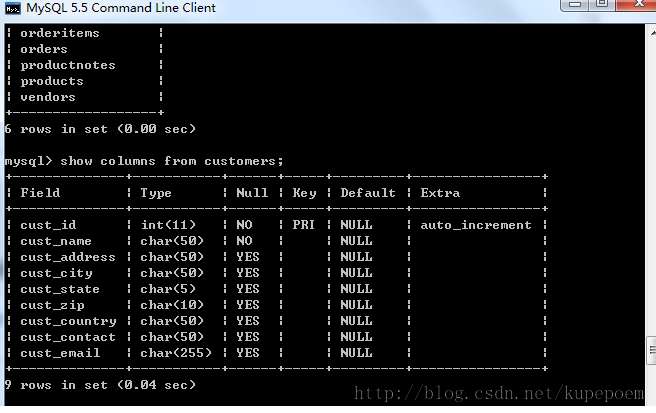Detailed introduction to aggregate functions
As you can see, it is very easy to use. But there are a few rules to be aware of when doing a merge. 1.UNION must be composed of two or more SELECT statements, separated by the keyword UNION (therefore, if 4 SELECT statements are combined, 3 UNION keywords will be used). 2. Each query in a UNION must contain the same columns, expressions, or aggregate functions (although the columns do not need to be listed in the same order). 3. Column data types must be compatible: the types do not have to be exactly the same, but must be a type that the DBMS can convert implicitly (for example, a different numeric type or a different date type). If these basic rules or restrictions are followed, you can use it for any data retrieval task. Including or suppressing duplicate rows We noticed that when executed separately, the first SELECT statement returned 4 rows and the second SELECT statement returned 5 rows. But after combining the two SELECT statements with UNION, only 8 rows were returned instead of 9. UNION automatically removes duplicate rows from the query result set (in other words, it behaves the same as a single SELECT statement
1. Example of UNION collation in MySQL combined query

##Introduction: As you can see, it is very easy to use, but there are a few rules to pay attention to when doing the merge. 1.UNION must be composed of two or more SELECT statements, separated by the keyword UNION (therefore, if 4 SELECT statements are combined, 3 UNION keywords will be used) 2. Each of the UNIONs. The query must contain the same columns, expressions, or aggregate functions (but the columns do not need to be listed in the same order)
##2.MySQL uses joins with aggregate functions.
 ##Introduction: Aggregate functions are used to summarize data. Although all examples of aggregate functions so far only summarize data from a single Tables summarize the data, but these functions can also be used with joins. To illustrate this, consider an example of retrieving all customers and the number of orders placed by each customer. The following code uses the COUNT() function to accomplish this. This works:
##Introduction: Aggregate functions are used to summarize data. Although all examples of aggregate functions so far only summarize data from a single Tables summarize the data, but these functions can also be used with joins. To illustrate this, consider an example of retrieving all customers and the number of orders placed by each customer. The following code uses the COUNT() function to accomplish this. This works:
3.
mysql data grouping: Create grouping ##Introduction: SQL aggregate functions can be used to summarize data. This allows us to count rows, calculate sums and averages, and obtain maximum and minimum values without retrieving all the data. Performed on all data in the table or data matching a specific where clause. As a reminder, the following example returns the number of products provided by supplier 1003
##Introduction: SQL aggregate functions can be used to summarize data. This allows us to count rows, calculate sums and averages, and obtain maximum and minimum values without retrieving all the data. Performed on all data in the table or data matching a specific where clause. As a reminder, the following example returns the number of products provided by supplier 1003
4. phpHow Output the following MySQL query results using aggregate functions and grouped data?
5. MySQL creates fields + data processing functions + summary data (aggregation functions) + grouped data_MySQL
6. Oracle 11g’s new aggregate function listagg implements column-to-row conversion
7. Oracle Basics Tutorial: Aggregation, Grouping, Row to Column
8. MySQL condition optimization example
Introduction: An example of MySQL condition optimization. The HAVING condition can not be incorporated into the WHERE condition under any circumstances. It can only be done if there is no GROUPBY condition or aggregate function in the SQL statement.
9. MySQL data summary and aggregation functions MySQL series (seven)
Introduction: MySQL data summary and aggregation functions - MySQL series (seven) ) 1. Aggregation function Aggregation function is a function that operates on row groups, calculates and returns a single function. SQL aggregate function function description AVG() Returns the average COUNT() of a certain column Returns the number of rows in a certain column MAX() Returns the maximum MIN() of a certain column Returns the minimum SUM() of a certain column Returns the sum of a certain column (1) , AV
##10. GROUPING, ROLLUP and CUBE in SQLServer
Introduction: Aggregation function: GROUPING is used Operators used to summarize data: ROLLUP 1. Use CUBE to summarize data. The result set generated by the CUBE operator is a multidimensional data set. Cubes are an extension of fact data, which is data that records individual events. Extensions are built on the columns the user intends to analyze. These columns are called dimensions. A cube is a result set, which contains
[Related Q&A recommendations]:
mysql - What is the principle of Group By? Will it affect performance if I supplement Groupby's columns to make them consistent with Select's columns (except for aggregate functions)?
The above is the detailed content of Detailed introduction to aggregate functions. For more information, please follow other related articles on the PHP Chinese website!

Hot AI Tools

Undresser.AI Undress
AI-powered app for creating realistic nude photos

AI Clothes Remover
Online AI tool for removing clothes from photos.

Undress AI Tool
Undress images for free

Clothoff.io
AI clothes remover

Video Face Swap
Swap faces in any video effortlessly with our completely free AI face swap tool!

Hot Article

Hot Tools

Notepad++7.3.1
Easy-to-use and free code editor

SublimeText3 Chinese version
Chinese version, very easy to use

Zend Studio 13.0.1
Powerful PHP integrated development environment

Dreamweaver CS6
Visual web development tools

SublimeText3 Mac version
God-level code editing software (SublimeText3)

Hot Topics
 When might a full table scan be faster than using an index in MySQL?
Apr 09, 2025 am 12:05 AM
When might a full table scan be faster than using an index in MySQL?
Apr 09, 2025 am 12:05 AM
Full table scanning may be faster in MySQL than using indexes. Specific cases include: 1) the data volume is small; 2) when the query returns a large amount of data; 3) when the index column is not highly selective; 4) when the complex query. By analyzing query plans, optimizing indexes, avoiding over-index and regularly maintaining tables, you can make the best choices in practical applications.
 Can I install mysql on Windows 7
Apr 08, 2025 pm 03:21 PM
Can I install mysql on Windows 7
Apr 08, 2025 pm 03:21 PM
Yes, MySQL can be installed on Windows 7, and although Microsoft has stopped supporting Windows 7, MySQL is still compatible with it. However, the following points should be noted during the installation process: Download the MySQL installer for Windows. Select the appropriate version of MySQL (community or enterprise). Select the appropriate installation directory and character set during the installation process. Set the root user password and keep it properly. Connect to the database for testing. Note the compatibility and security issues on Windows 7, and it is recommended to upgrade to a supported operating system.
 Explain InnoDB Full-Text Search capabilities.
Apr 02, 2025 pm 06:09 PM
Explain InnoDB Full-Text Search capabilities.
Apr 02, 2025 pm 06:09 PM
InnoDB's full-text search capabilities are very powerful, which can significantly improve database query efficiency and ability to process large amounts of text data. 1) InnoDB implements full-text search through inverted indexing, supporting basic and advanced search queries. 2) Use MATCH and AGAINST keywords to search, support Boolean mode and phrase search. 3) Optimization methods include using word segmentation technology, periodic rebuilding of indexes and adjusting cache size to improve performance and accuracy.
 Difference between clustered index and non-clustered index (secondary index) in InnoDB.
Apr 02, 2025 pm 06:25 PM
Difference between clustered index and non-clustered index (secondary index) in InnoDB.
Apr 02, 2025 pm 06:25 PM
The difference between clustered index and non-clustered index is: 1. Clustered index stores data rows in the index structure, which is suitable for querying by primary key and range. 2. The non-clustered index stores index key values and pointers to data rows, and is suitable for non-primary key column queries.
 MySQL: Simple Concepts for Easy Learning
Apr 10, 2025 am 09:29 AM
MySQL: Simple Concepts for Easy Learning
Apr 10, 2025 am 09:29 AM
MySQL is an open source relational database management system. 1) Create database and tables: Use the CREATEDATABASE and CREATETABLE commands. 2) Basic operations: INSERT, UPDATE, DELETE and SELECT. 3) Advanced operations: JOIN, subquery and transaction processing. 4) Debugging skills: Check syntax, data type and permissions. 5) Optimization suggestions: Use indexes, avoid SELECT* and use transactions.
 The relationship between mysql user and database
Apr 08, 2025 pm 07:15 PM
The relationship between mysql user and database
Apr 08, 2025 pm 07:15 PM
In MySQL database, the relationship between the user and the database is defined by permissions and tables. The user has a username and password to access the database. Permissions are granted through the GRANT command, while the table is created by the CREATE TABLE command. To establish a relationship between a user and a database, you need to create a database, create a user, and then grant permissions.
 Explain different types of MySQL indexes (B-Tree, Hash, Full-text, Spatial).
Apr 02, 2025 pm 07:05 PM
Explain different types of MySQL indexes (B-Tree, Hash, Full-text, Spatial).
Apr 02, 2025 pm 07:05 PM
MySQL supports four index types: B-Tree, Hash, Full-text, and Spatial. 1.B-Tree index is suitable for equal value search, range query and sorting. 2. Hash index is suitable for equal value searches, but does not support range query and sorting. 3. Full-text index is used for full-text search and is suitable for processing large amounts of text data. 4. Spatial index is used for geospatial data query and is suitable for GIS applications.
 Can mysql and mariadb coexist
Apr 08, 2025 pm 02:27 PM
Can mysql and mariadb coexist
Apr 08, 2025 pm 02:27 PM
MySQL and MariaDB can coexist, but need to be configured with caution. The key is to allocate different port numbers and data directories to each database, and adjust parameters such as memory allocation and cache size. Connection pooling, application configuration, and version differences also need to be considered and need to be carefully tested and planned to avoid pitfalls. Running two databases simultaneously can cause performance problems in situations where resources are limited.






